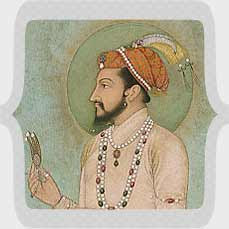During his 50-year reign, Akbar accumulated much wealth from the political and commercial centers in northern India. His immediate successors, Jahangir and Shah Jahan, were able to surround themselves with a splendor and opulence unequaled by any other Muslim dynasty.
From the beginning, Jahangir's life was overshadowed by the achievements of his father Akbar. Jahangir grew up resentful of his masterful parents and bitterly jealous of his father's long-established coterie of advisers who must have interfered between father and son. Hambly writes that despite Jahangir's acute intelligence, the Mughal ruler was generally indifferent to the larger interests of the empire. Moreover, he lacked any obvious inclination for warfare and was bored by the humdrum details of day-to-day administration. Jahangir was self-indulgent and sensual with a streak of cruelty that emanated from a weak personality.
Despite Jahangir's disinterest in expansion, the imperial frontiers continued to move forward -- in Bengal, Mewar and Ahamadnagar. The only major reversal to the expansion came in 1622 when Shah Abbas, the Safavid ruler of Iran, captured Kandahar with impunity.
Jahangir lived under the spell of personalities that were more colorful than his own; the most influential of these personalities was the beautiful Nur Jahan whom he married in 1611. Nur Jahan then became the real ruler of the empire until the death of her husband Jahangir.
Nur Jahan's Persian grandfather was in the service of Shah Tahmasb; the grandfather died in Yazd laden with honors. His heirs, however, soon fell upon hard times, and his son, Mirza Ghiyas al-Din Muhammad, was forced to set out for India with his family. In 1577, during the trip to India, his wife gave birth at Kandahar to a eautiful daughter, Mihr al-Nisa (Sun of Women). Later, Jahangir would give Mihr al-Nisa the name of Nur Mahal (Light of the Palace) which he later expanded to Nur Jahan (Light of the World).
Mihr al-Nisa's father, Mirza Ghiyas al-Din Muhammad, made his way to Akbar's court at Fatehpur Sikri and rose rapidly in the imperial hierarchy. He held many important positions including that of diwan of Kabul; he ended his days with the rank of commander and the proud title of Itimad al-Dawleh (Pillar of the State). His son, Asaf Khan, was an urbane and affable courtier and a sharp fiscal administrator who secured the favor of both Jahangir and Shah Jahan, writes Hambly.
The son attained the highest provincial governorships and finally the rank of commander-in-chief. Hambly notes that in 1612, a year after Mihr al-Nisa's marriage to Jahangir, Asaf Khan arranged for his daughter, Arjumand Banu Begum, to marry Prince Khurram, one of Jahangir's younger sons. Fifteen years later, Khurram would ascend to the throne as the emperor Shah Jahan. Nur Jahan's niece would win immortality as Mumtaz Mahal, the woman in whose honor the Taj Mahal was built.
Jahangir's wife, Nur Jahan, was an excellent conversationalist, a fine judge of Persian poetry and a poet herself. Her accomplishments made her an irresistible companion for the emperor. Nur Jahan was a patron of painting and architecture whose interests also extended to the decoration of rooms as well as the designing of ornaments, brocades, rugs and dresses. The fashions in women's clothing that she adopted were still in vogue at the end of the 16th century.
Nur Jahan was Jahangir's favorite companion. She shared his interests in fine artistic objects and precious stones. Nur Jahan also assisted Jahangir in the layout and design of Persian gardens like the beautiful Shalimar-Bagh on the Dal Lake in Kashmir.
Jahangir's love of flowers and animals is reflected in the numerous miniatures painted by artists who shared their master's keen eye for the beauties of wild nature. Sir Thomas Roe, the ambassador of James I of England, was amazed at Jahangir's knowledge and discriminating taste where pictures were concerned.
Jahangir was not particularly interested in architecture, but one of the buildings that dates from his reign ranks among the finest achievements of the Mughal spirit. This is the tomb of Mirza Ghiyath Beg, usually known by his title I'timad ad-Dawlah (Pillar of the State), built at Agra by Nur Jahan (Light of the World) for her father who died in 1622. The tomb stands in a quadripartite garden. The enclosure walls, a guest-house on the river Yamuna and the podium are made of traditional red sandstone inlaid with colored marble.
The tomb of I'timad ad-Dawlah is the first structure in India in which white marble replaces red sandstone as the ground for polychrome pietra dura inlay. The tomb, measuring about 22 yards on a side, contains a central tomb chamber surrounded by square and rectangular rooms decorated with carved painted plaster in the Persianate style. The broad octagonal towers, like minarets, mark the corners, and a small pavilion or upper story rises above the roof. Three arched openings on each side provide shadows which contrast with the gleaming surface, while the cornice and eaves mark strong horizontal lines.
The modest, jewel-like building is remarkable for its delicate but exuberant decoration and warm tonality. The traditional technique of inlay has changed; opus sectile, marble intarsia of various colors, has been replaced by pietra dura, in which hard and rare stones such as lapis, onyx, jasper, topaz, carnelian and agate were embedded in the marble.
Traditional geometric designs and arabesques are combined with representational motifs of drinking cups, vases with flowers, cypress trees and visual descriptions of Paradise from the Holy Qur'an. The intricate inlay in yellow, brown, gray and black, contrasting with the smooth white marble, prefigures the later phase of white marble garnished with gold and precious stones that marks the most sumptuous buildings constructed under later Mughal patronage.

No comments:
Post a Comment